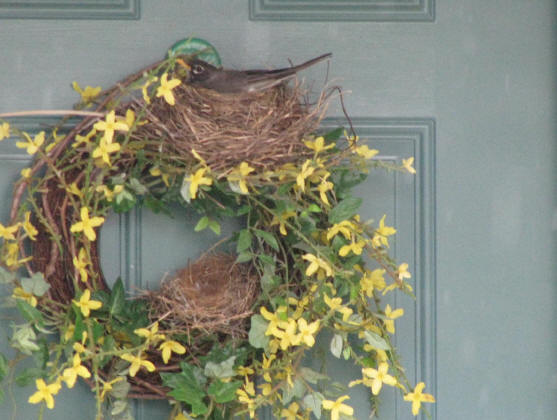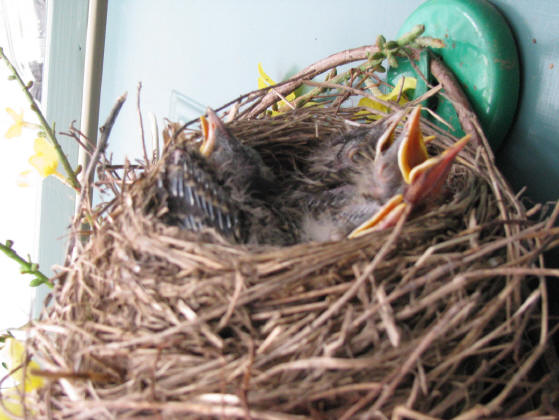 In the photos you will see a front door "bird duplex" built in our silk and grapevine wreath this spring. In the past, we’ve had nesting house finches – anyone brave enough to keep a spring wreath on the door probably has had a
similar experience. The difference this year is that the finches built a "lower deck" nest and the robins built an "upper deck" nest. Unfortunately, a predator bird raided the finch nest and eggs ended up on the porch floor; the good news is the robins successfully hatched a brood of 3 youngsters.
In the photos you will see a front door "bird duplex" built in our silk and grapevine wreath this spring. In the past, we’ve had nesting house finches – anyone brave enough to keep a spring wreath on the door probably has had a
similar experience. The difference this year is that the finches built a "lower deck" nest and the robins built an "upper deck" nest. Unfortunately, a predator bird raided the finch nest and eggs ended up on the porch floor; the good news is the robins successfully hatched a brood of 3 youngsters.
On the opposite side of the house, we have a 25 foot "I" beam on our lower patio that supports the outer upper deck of the house. That "I" beam is a perfect ledge for robin nests; with cross beams dividing it for additional support to the deck, each section appears to be a perfect nesting box open
to the inside of the patio. Each spring the robins wage war with my husband, building nests faster than he can remove them. Jack has resorted to hanging foil pie plates from the "I" beam which deter some, but not all, of the robins - the last of those fledglings are ready to leave the nest as of this July writing!)

We have 2 prolific mulberry trees to the rear of our property. As the berries ripen in June, the trees become alive with birds and squirrels feasting on the ripening berries.
Beyond the mundane bird population we see daily at Lake Meade, we see a plethora of more colorful varieties. The blue jay and cardinal populations multiply. Orioles, Tangers and Bluebirds visit more often than normal. The trade off, of course, is that there are remnants of those purple berries
randomly left by the birds as they pass over our deck. This year I saw a squirrel curled up in a spot where 3 large branches join – napping with his little belly full of mulberries. As you read this, the berries will be spent and the burst of backyard activity will be waning, I expect – great fun while it lasted…..
The American Goldfinch is the last of our native birds to nest. This bird is feeding at our Niger feeders just waiting for the native wild thistle to bloom. Once the blossom matures, the American Goldfinch will use the down from this plant to line its nest. I have yet to see a Goldfinch nest, but I
continue to watch for one.
Finally, the hummingbird is probably our happiest, busiest visitor. There are reports of 30-40 of these little hummers swarming around bird feeders in recent banner years. One nearby family member in past years has filled all 3 of her feeders on a daily basis, to have them drained by her
hummingbirds before the end of the day. So far, observations are that hummers in this locale are not as plentiful as in some years or later in the summer.
It may be too early for optimum activity; someone else nearby may have a better perch, who knows? Early summer in south central PA may have just been a bit cool for these little tropical visitors. Patience will most certainly pay off at our house when the cardinal flowers are in full bloom. The red
tips are just beginning to show in early July; this bloom has in the past been a meal the hummers just can’t resist. We’ll continue to keep watch for little ruby throats and listen for their drumming wings.
Quite a few flowers serve to entice the hummingbird to one’s yard. Annual Superbells (tiny petunias) of all colors in containers attract them; perennials include cardinal flower, trumpet honeysuckle, bush or shrub honeysuckles, bee balm (monarda), salvia, coral bells, penstemon, red-hot poker and
verbena to name just a few. I encourage planting one or more of the above for hummers who visit. Good guidance for those who hang feeders is NOT to remove the feeders this Labor Day, but rather keep them out so that migrating hummingbirds can replenish as they make their annual migrations south.

The natural habitat of our local birds and butterflies seems to be on the decline. Winged as well as four-legged critters can be challenged with our trend toward urban sprawl. For example, the common milkweed is on the decline in urban areas as road crews spray vegetation to maintain the appearance
of our highways. Who cares, you might ask?
For one, the monarch butterfly, who is challenged to find food for its larva due to the decline of the common milkweed. This plant is the host for the monarch and provides a natural means of deterring predators – milkweed sap or "milk" is toxic to most who would consume it, but not to the monarch
larva. By ingesting the liquid as it feeds, the emerging butterfly’s toxicity serves to repel predators. This example is just one of many that shows how nature hangs in a delicate balance as we humans continue efforts to manage the world around us!
Read other articles on birds, wildlife & beneficial insects
Read other summer related gardening articles